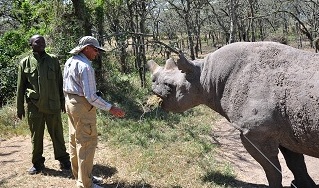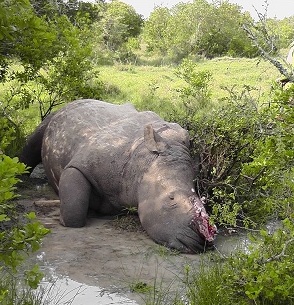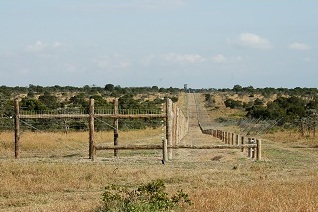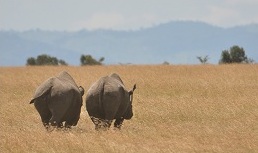Rhino Poaching
Rhino Poaching
Meera Subramanian: Rhino Poaching
 As my seventy-six-year-old father reached out across the wire fence to touch the rhino, his face lit up like a little kid?s. Baraka, which means ?blessings be? in languages from Africa to Asia, is a black rhino at the Ol Pejeta Conservancy in central Kenya, where we visited last year. He is unable to return to the wild where he was born, after losing one eye in a fight and the other to a cataract. Most of his two horns were removed to make him less appealing to poachers. Now he serves as the public ambassador for rhino conservation, mingling with the tourists and accepting their handfuls of hay. And making older men, and thus their daughters, smile.
As my seventy-six-year-old father reached out across the wire fence to touch the rhino, his face lit up like a little kid?s. Baraka, which means ?blessings be? in languages from Africa to Asia, is a black rhino at the Ol Pejeta Conservancy in central Kenya, where we visited last year. He is unable to return to the wild where he was born, after losing one eye in a fight and the other to a cataract. Most of his two horns were removed to make him less appealing to poachers. Now he serves as the public ambassador for rhino conservation, mingling with the tourists and accepting their handfuls of hay. And making older men, and thus their daughters, smile.
Nearby, a southern white rhino named Max lingered, though he was free to roam the 90,000-acre private conservancy. We only saw him from a distance. On June 30 this year, after staff heard shots, he was found dead with seventeen bullets in him. Both his horns had been removed by poachers, although staff had essentially dehorned him six months ago, like they had Baraka, leaving nothing but small stumps. Max was an orphaned rhino who had been hand-reared from the age of two weeks, but he had been successfully reintroduced into the wild. He?d been part of a small herd and was establishing his own territory as he headed into his sixth year, although he still enjoyed the presence of people. Just a month earlier, Max was featured, presciently, on the BBC?s ?Last Chance to See: A Search for Animals on the Edge of Extinction? program. A week later, in July, another rhino was poached on the same conservancy, and last week there was another attempt that left a third rhino gravely wounded.
 ?No one is doing a thing about it. What we need is more money, more support, and we need to stop the demand,? said Elodie A. Sampéré, head of conservation marketing at Ol Pejeta Conservancy. The demand comes partly from Yemen, where the horns are carved into prized dagger handles, but increasingly the appetite is Asian in origin, where powder from the horn is believed to cure everything from fever to ?devil possession.? It?s not, as commonly believed, used as a traditional Chinese version of Viagra.
?No one is doing a thing about it. What we need is more money, more support, and we need to stop the demand,? said Elodie A. Sampéré, head of conservation marketing at Ol Pejeta Conservancy. The demand comes partly from Yemen, where the horns are carved into prized dagger handles, but increasingly the appetite is Asian in origin, where powder from the horn is believed to cure everything from fever to ?devil possession.? It?s not, as commonly believed, used as a traditional Chinese version of Viagra.
Last year?s celebration of the International Year of Biodiversity seems to have had little impact on anything living on the ground. There has been a recent surge in poaching across Africa, with 193 rhinos killed in South Africa alone in the last six months and record levels of trafficking in wildlife remains that find their way overseas, mainly to China. Add the torrent of Chinese-backed road building in Kenya, and suddenly it?s easier than ever to supply the growing Asian market, where a booming economy means more people can afford the expensive, illicit products. What poor Kenyan wouldn?t consider taking the risk of poaching when a pair of black rhino horns can fetch up to $100,000?
There are forty-eight Javanese rhinos left, and 200 Sumatran, with maybe fifty of those in Borneo. There are fewer than 3,000 rhinos in India; Africa remains a relative stronghold. White rhinos, which derive their name from the Afrikaans word weit (?wide?), for their wide mouths, are divided into two distinct subspecies. The southern white rhinos like Max are doing relatively okay, with about 20,000 in the wild, only reaching the near-threatened status on the International Union for Conservation of Nature Red List. The northern white rhinos, on the other hand, are not doing so well. There are eight. As in eight individuals. Four of them live at Ol Pejeta, behind a double barbed wire fence.  With this few, a genetic bottleneck is formed, and the only chance to keep the genes of the northern white in something other than a lab vault is to breed them with the southern white. It?s a wall that conservationists hit when a species populations number gets too low, when one must bastardize in order to preserve.
With this few, a genetic bottleneck is formed, and the only chance to keep the genes of the northern white in something other than a lab vault is to breed them with the southern white. It?s a wall that conservationists hit when a species populations number gets too low, when one must bastardize in order to preserve.
Ol Pejeta also serves as the largest black rhino sanctuary in East Africa, after twenty-seven more rhinos were translocated there in 2007, bringing the total number to eighty-five. In Kenya, the numbers of black rhinos dropped from an estimated 20,000 in the 1970s to fewer than 300 animals in the 1980s. Now there are about 4,000 to 5,000 in existence.
This is life completely out of balance. A fascinating piece by Fred Pearce on Yale Environment 360 last year brings a striking historical light to what seems like the eternal plight of East Africa. In short, imagine an Africa before the Europeans graced its shores, with tribes rich with cattle and growing fields of wheat. In 1887, Italian explorers arrived during their jaunt around the world, bringing livestock they?d collected in Asia, which carried the virus that causes rinderpest. The disease literally wiped out the ungulate (hoofed) population, domesticated and wild. People lost their meat, their milk, the labor force for their plows. That was the first blow in a one-two punch. The second came when the lowland brush sprung up where the ungulates had once grazed, and with it the tsetse fly, which causes sleeping sickness in humans and animals and is today only second to AIDS as an obstacle to development in Africa.

SOMETHING ELSE striking happened on that trip to Ol Pej last year. As we drove across the wide-open savannah we saw two black rhinos, which usually stay in the brush, since they browse on leaves instead of grazing on grass. Together, the old pair, ears notched and hides marked with scars, walked up to a mound of rocks under an acacia tree. Teeku, our guide, who had been coming there for years, told us it was the grave of an especially favored rhino that had lived and died at Ol Pejeta. The two rhinos walked around the stones, ate some lush green creepers that were reaching out between the rocks, and then turned and walked back across the plain towards their more typical habitat.
 Something about those retreating flanks was haunting. Had those green creepers enticed them from afar, or did they know that one of their kind was down below the mound? I?ll never know, but I felt like I was watching a pair of ghosts disappear across the horizon as they departed. I hope I was wrong.
Something about those retreating flanks was haunting. Had those green creepers enticed them from afar, or did they know that one of their kind was down below the mound? I?ll never know, but I felt like I was watching a pair of ghosts disappear across the horizon as they departed. I hope I was wrong.
You can support Ol Pejeta Conservancy here.






